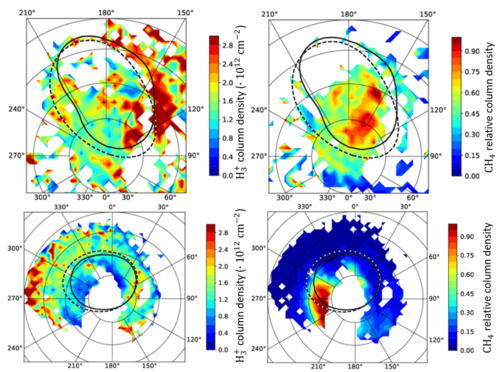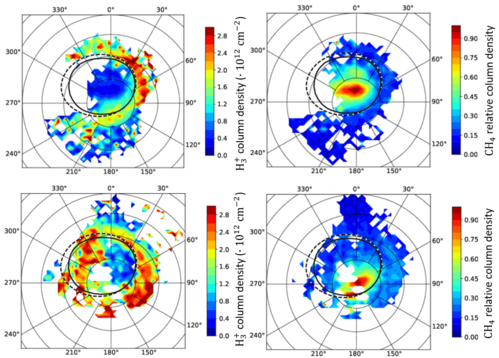Study of Jupiter’s auroral regions through the measurement of the Juno/JIRAM instrument
- 1INAF, IAPS, Rome, Italy (chiara.castagnoli@inaf.it)
- 2ISAC, CNR, Bologna, Italy
- 3ISAC, CNR, Rome, Italy
- 4Agenzia Spaziale Italiana, Rome, Italy
The Jovian InfraRed Auroral Mapper (JIRAM) instrument aboard NASA’s Juno spacecraft, which has been orbiting Jupiter since July 2016, is an imager/spectrometer designed to monitor the atmosphere of Jupiter and its aurorae. Due to Juno’s polar orbit, the poles of the planet have been observed with a much higher spatial resolution than previous space missions. In this work, JIRAM data measured over the polar regions have been used to derive quantitative information on the species CH4 and H3+ and on the variability of their spatial distribution in Jupiter’s auroral regions. During the first Juno’s orbit around Jupiter a large number of measurements have been collected in the auroral regions, showing both the emissions of H3+ and CH4 in the 3-4 µm spectral range. Various analyses have then been performed on JIRAM’s first sequence of observations of Jupiter’s north and south poles. Using the retrieval code developed to analyse JIRAM spectra, the H3+ effective temperatures and column densities (CD) have been retrieved. Moreover, considering the detection of methane emissions in the Jovian aurorae, in the retrieval analysis the CH4 contribution to the spectral signature has been considered and the methane’s column density has also been retrieved. In light of such results, this work aims to integrate the work already done on JIRAM’s auroral observations acquired at nadir over Jupiter’s poles during the first Juno’s orbit and to extend it to the subsequent orbits where the instrument provided an optimal coverage of the auroral regions.
In this study, JIRAM spectra have been analysed in the spectral region from 3 to 4 μm, that is particularly favourable for the study of the auroral emissions due to the quasi-total absorption of the incoming solar radiation from the lowest layers of Jupiter atmosphere. Starting from the data previously analysed for the orbit JM0003, the dataset has been enlarged to include observations outside the auroral ovals with a lower signal and extending the analysis to successive orbits. The first 10 Juno’s orbits, from JM0003 to JM0091, covering overall the period August 2016-October 2017, have been examined to detect the ones with both good polar coverage of the spectrometer measurements and good signal to noise ratio (table1). Along to the JM0003, where both the polar regions have been successfully covered, the orbits JM0071 and JM0081 have been found particularly promising for the study of the southern auroral region.
table 1 Number of spectra analysed for each of the selected orbits.
The selected spectra show the presence of and emissions in both the southern and the northern auroras and have been analysed using an inversion technique based on a Bayesian approach. Preliminary tests have allowed the optimization of the a-priori information vector and the corresponding error for the new dataset (table 2). These tests have highlighted that only the abundances of the two species and the H3+ temperature could be independently retrieved. The other parameters have been set to average values found in the preliminary tests where all the variables listed in table 2 have been retrieved.
table 2 Input values of the retrieval parameters and the relative a-priori errors.
The results of this work have confirmed the presence of a significant concentration of methane within the auroral oval in both polar regions and found comparable abundances of H3+ in the two auroral regions, with values generally ranging from 2.0·1012 cm-2 to 2.8·1012 cm-2 with some peaks larger than 2.8·1012 cm-2 (figure 1 and 2). Moreover, as already suggested by previous studies, an anticorrelation between H3+ CD and T has been observed. The H3+ temperatures appear lower in the south aurora, where on average the values do not exceed 800 K, while in the northern aurora the temperatures span between 800 K and 950 K . Also, the retrieval of background spectra has highlighted new auroral features, not previously observed. Finally, a comparison of these results with the images acquired by the JIRAM imager has allowed to study the morphology of the Jovian aurorae and to highlight the shifting over the time of a few degrees westward of the south aurora.

figure 1 Distribution maps of the (left) and (right) retrieved column densities the orbit JM0003: (top) north pole, (bottom) south pole.

figure 2 Distribution maps of the (left) and (right) column densities retrieved in Jupiter’s southern aurora for the orbit JM0071 (top) and JM0081 (bottom).
How to cite: Castagnoli, C., Dinelli, B. M., Altieri, F., Migliorini, A., Mura, A., Moriconi, M. L., Adriani, A., Sordini, R., Tosi, F., Piccioni, G., Grassi, D., Moirano, A., Noschese, R., Cicchetti, A., Sidoni, G., Plainaki, C., and Olivieri, A.: Study of Jupiter’s auroral regions through the measurement of the Juno/JIRAM instrument, Europlanet Science Congress 2021, online, 13–24 Sep 2021, EPSC2021-113, https://doi.org/10.5194/epsc2021-113, 2021.

